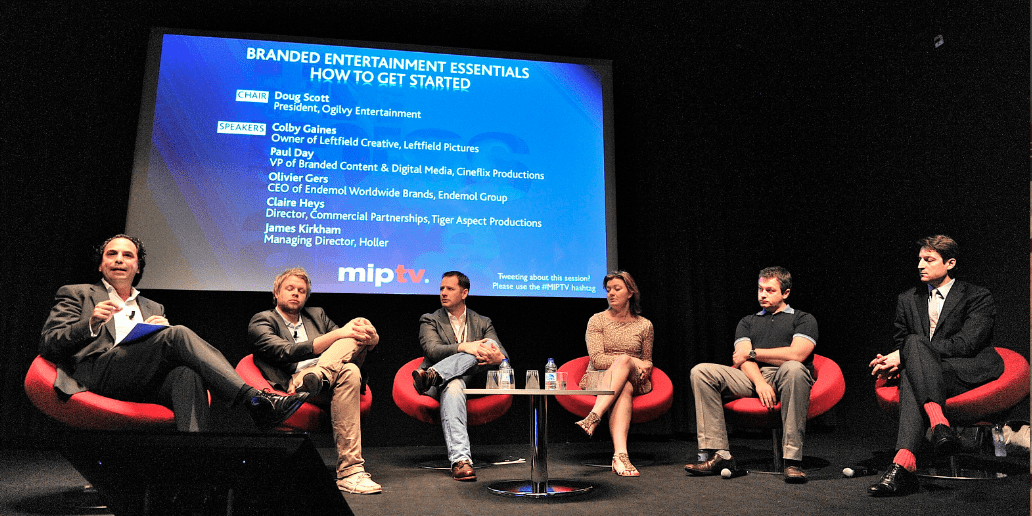Left to right: Ogilvy Entertainment president Doug Scott, Holler managing director James Kirkham, Leftfield Creative owner Colby Gaines, Tiger Aspect Productions director of commercial partnerships Claire Heys, Cineflix Productions VP of branded content & digital media Paul Day, Endemol Worldwide Brands CEO Olivier Gers.
“The sooner we all come together to enable and test new models, the more advanced we’re gonna get in terms of this entertainment space,” began Ogilvy Entertainment president Doug Scott. For users, our work is a way for us to express our realities while enabling watchers to escape the one they live in.
This manifesto was followed by a clip from 30Rock that illustrates the concept of “product integration” to producers. The sketch grew progressively so frenzied, so loaded with historical references to brands in TV, that it quickly devolved into noise. This set up the first challenge: how to avoid being noise?
But Gers said we must be careful not to condemn product placement. It brings interesting things to the viewer, value to the show and to the brand. There’s still money to be made; the key is not to believe that it’s enough.
“Placement is only as good as your ability to extend that and activate it,” Scott agreed, saying brands often make the mistake of seeing product placement as “the end all be all” without fully leveraging or appreciating “the equity they’re borrowing from someone else.”
“Everybody talks about content, but… branded entertainment is something very specific. I think it’s entertainment funded by the brand,” said Gaines, who emphasised that it has to be entertainment before anything if it’s to be effective for the brand at all.
Kirkham pointed to Red Bull, whose brand is part and parcel of the experience that it creates and wraps around fans and sports players.
“The exciting thing is that when you meet brands that are really open to let you create content entertainment, that will move the needle but isn’t overt … I think brands are opening their minds a little bit more and sort of allowing producers to produce … to achieve the end goal, to make people consume,” said Gaines.
Kirkham seized this opportunity to talk about “I Am Playr”, a transmedia game that Nike is involved in. You can run in real life, which gives you credits as a footballer in the game itself. There are also cinematic elements, affected by your degree of engagement.
“True transmedia,” Scott said reverently.
Scott credits “Contagious Magazine” for recently bringing him from a 360° mindset to a 365 mindset: this idea that you can be with a consumer every day, present in his life with the same nearly-disturbing intimacy as their mobile phone.
“I think brands with the equity they have, have the ability to provide a greater sense of utility” to the life of a consumer. On the other hand, and going back to the example of Red Bull, “I don’t think every brand has the ability, or permission, to go out there and become a media company.”
“If you have distribution, you have one-half of everything,” Gaines said. “If you find a network that’s open to helping you be 365, you’ve got a winner.”
“Every business model is different,” Day reminded listeners. “The most important thing is to be flexible.” Define what success is for the brand, what success is for you in terms of content. “Often, what success is changes during the process and you have to be adaptable to that.” Focus on the end game and incorporate unexpected metrics or opportunities that serve it.
“That sounds really obvious but actually people don’t do that every time,” he added.
“At the end of the day, we need to establish a dialogue with the brand,” said Gers. The agency will bring something to that dialogue, certainly, but it can’t be fully relied-upon to do the heavy lifting of engagement on behalf of production companies. You’ll need your own facetime.
“I will not go forward with a deal unless I’ve seen the whites of the eyes of the client that I’m working with,” Heys said.
“Getting the brands, different agencies to work together, that’s a tricky one sometimes,” she went on, gently addressing the ever-present tension between production companies and agencies. “I do what Paul does: ask the client to define for me what the metrics for success are … and it’s very hard to get them to define them … but you just must.”
Easier said than done, said Gaines, because brands often come wanting a “viral hit” or something like that, lending the sense that there’s a success metric back there… but when you show them what needs to be done creatively to make that happen, they blanche. “You need to find open brands…”
“Brave brands,” Heys corrected.
“Brave brands,” Gaines reappropriated, charmed.





2 Comments
Pingback: Liveblog: Branded Entertainment Essentials: How to Get Started … « Carlton Enoch "On the Streets" Twitter Blog
Pingback: TWEED : MIPTV Recap